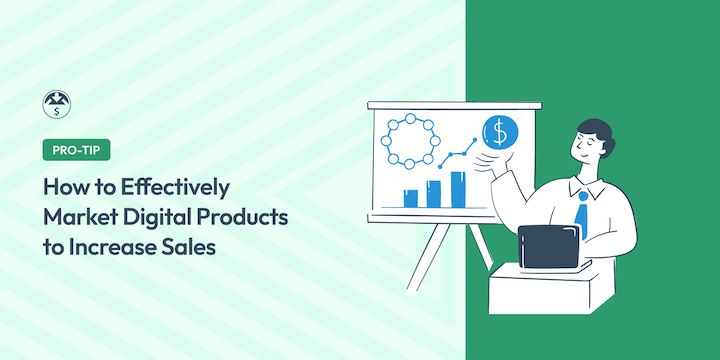
Are you trying to figure out how to market digital products?
Creating a digital product that you’re proud of is exciting. The real challenge is getting people to buy it.
If you’re new to eCommerce and don’t know anything about digital product marketing, don’t worry. While product promotion can be tricky, it doesn’t have to be.
You can use plenty of simple strategies and tools to market your products and set yourself up for success.
🔎 In this article, I’ll cover:
What Is Digital Product Marketing?
Digital product marketing is the process of promoting and selling digital products or services online.
Digital products encompass a wide range of offerings, including:
- Ebooks and digital publications
- Online courses and tutorials
- Software and applications
- Digital art, printables, templates, and stock photography
- Music and audio
Unlike physical products, digital goods are intangible, which require a different approach to reach and engage customers.
You need to focus on creating value and building trust with your audience.
Why Market Digital Products?
A well-executed marketing strategy can turn your digital product from a mere idea into a profitable venture.
Learning how to properly promote and market digital products can lead to:
- Increased sales and revenue: A solid digital marketing strategy can significantly boost your sales.
- Enhanced brand visibility: By promoting your digital products, you can increase brand awareness and recognition.
- Stronger customer relationships: Engaging with your target audience through marketing builds trust and loyalty.
- Competitive advantage: Differentiating your product through effective marketing can help you stand out in a crowded market.
Beyond that, using strategies to market digital products can build brand awareness, strengthen customer relationships, and increase customer engagement. By effectively marketing your digital downloads, you can position yourself as an authority in your niche.
How to Market Digital Products & Downloads
Now, let’s get down to the nitty-gritty. There are a handful of useful and powerful digital marketing strategies you can use to promote your products and increase sales online.
But before you begin actually creating and launching your marketing campaigns, it’s important to have a solid understanding of what your product is, who it’s intended for, and what your marketing strategy for digital products is going to be.
Let’s start by looking at some step-by-step guidance on building your strategy to market digital products. Then we’ll get into some specific tactics and tools that will help boost your success.
1. Identify Your Target Audience
Knowing your target audience is crucial for successful marketing. Create detailed buyer personas to understand their needs, preferences, and pain points. This information will guide your marketing efforts.
Creating Buyer Personas
A buyer persona is a fictional representation of your ideal customer. It helps you visualize and understand your target audience on a deeper level. To create effective buyer personas, consider the following factors.
| Demographics | Age, gender, location, income, education level, occupation. |
| Psychographics | Interests, hobbies, values, lifestyle, challenges, goals. |
| Behavior | Online habits, purchasing behavior, social media usage, preferred communication channels. |
| Pain points | Problems or challenges your target audience faces. |
| Goals | What your target audience hopes to achieve. |
Understanding Customer Needs & Preferences
Once you have a clear picture of your target audience, delve deeper into their needs and preferences. Conduct market research, surveys, and customer interviews to gather valuable insights. Analyze customer feedback and reviews to identify common pain points and desires.
By understanding your customers on a deeper level, you can create products and marketing messages that resonate with them. This knowledge will guide your product development, content creation, and promotional efforts.
2. Develop a Strong Value Proposition
What makes your digital product unique?
A compelling value proposition clearly communicates the benefits of your digital product and differentiates it from competitors. It should resonate with your target audience, addressing their specific needs and desires.
Key components of a strong value proposition include
- Customer problem: Clearly articulate the problem your product solves.
- Product solution: Explain how your product addresses the customer’s problem.
- Unique benefits: Highlight the unique advantages your product offers.
- Call to action (CTA): Encourage customers to take the next step.
To develop an effective value proposition, keep it as concise and clear as possible. Use simple language that is easy to understand.
In addition, continuously evaluate your value proposition and make adjustments as needed.
3. Build a Sales Funnel
A sales funnel is a structured process that guides potential customers from initial awareness to becoming paying customers. It involves a series of steps designed to nurture leads and convert them into buyers.
| Awareness | Attract potential customers through content marketing, social media, and SEO. |
| Interest | Capture leads by offering valuable content like ebooks, webinars, or free trials in exchange for email addresses. |
| Desire | Nurture leads through email marketing and targeted content to build trust and interest in your product. |
| Action | Convert leads into customers through compelling offers, limited-time discounts, or free trials. |
| Retention | Build customer loyalty through excellent customer support, post-purchase offers, and community building. |
Similar to a digital marketing strategy, establishing a solid sales funnel requires you to understand your ideal customer, set clear goals, and choose the appropriate channels.
4. Use the Right Channels to Market Digital Products
Selecting the appropriate sales channels is crucial for reaching your target audience and maximizing sales.
Some important factors to consider:
- Target audience: Where do your customers spend their time online?
- Product type: Some platforms are better suited for specific types of digital products.
- Competition: Assess the level of competition on each platform.
- Fees and commissions: Compare the costs associated with each sales channel.
- Ease of use: Consider your technical expertise and the platform’s user-friendliness.
There are numerous channels to sell your digital products. The three main options are to use your own online store, a third-party marketplace like Etsy or Gumroad, or social media platforms.
While online marketplaces can help reach a vast audience, that also means higher competition. Plus, you have significantly less control over customization, pricing models, customer communications, etc.
I highly recommend using a direct sales channel and creating your own website. This offers you complete control over the customer experience and branding. It’s also incredibly easy.
WordPress and Easy Digital Downloads is the perfect solution for building an online store and selling digital products.

Easy Digital Downloads provides eCommerce features like payment processing, download management, and customer management.
Building a Multi-Channel Strategy
While focusing on one channel may seem tempting, a multi-channel approach can yield better results. By diversifying your sales channels, you can reach a wider audience and increase your chances of success.
For instance, in addition to your own website, you could incorporate social media sales channels as you go. Not only can they be effective tools for increasing sales, but they’re also prime avenues to use to grow your audience and promote digital products.
Important Considerations:
- Consistent branding: Maintain a cohesive brand image across all channels.
- Product information: Ensure product descriptions and images are accurate and consistent.
- Inventory management: Effectively manage product availability across different platforms.
- Customer support: Provide excellent customer service regardless of the sales channel.
By carefully considering these factors and implementing a well-rounded sales channel strategy, you can optimize your digital product marketing efforts and achieve your sales goals.
5. Establish a Pricing Strategy
Pricing your digital product can be challenging. Consider factors like production costs, competitor pricing, and perceived value. Experiment with different pricing strategies to find what works best for your product.
Some pricing tips to keep in mind:
- Experiment with different pricing models to find what works best.
- Offer discounts and promotions to attract customers with limited-time offers or bundle deals.
- Consider upselling and cross-selling to increase average order value.
- Use pricing psychology techniques to influence customer perception.
- Continuously monitor and make necessary adjustments.
Experimenting with different pricing strategies can help you find the optimal price point for your digital product. Easy Digital Downloads lets you implement a variety of pricing models. This includes tiered pricing and memberships, flat fees, etc.
6. Build a Pre-Launch Campaign
Generate excitement for your product launch with a pre-launch campaign. Build an email list, create social media buzz, and offer exclusive pre-order bonuses to create a strong foundation for your launch.
You can use a pre-launch campaign to:
- Build anticipation: Create excitement and curiosity about your product through teasers, sneak peeks, and countdown timers.
- Collect email addresses: Build your email list to nurture leads and inform potential customers about the launch.
- Offer incentives: Provide exclusive bonuses or early bird discounts to encourage sign-ups.
- Gather feedback: Collect valuable input from potential customers through surveys or beta testing.
- Leverage social media: Create engaging content and build a community around your product.
In the next sections, I’ll go into more detail on the specific tools you can use for marketing campaigns.
Effective Ways to Market Digital Products
To reach a wider audience and drive sales, you need to implement effective marketing strategies. These tactics will help you build brand awareness, generate leads, and convert customers.
Search Engine Optimization (SEO)
Search Engine Optimization (SEO) is crucial for increasing your website’s visibility in search engine results.
Optimize your product pages, blog posts, and website content with relevant keywords to attract organic traffic.
Start by conducting keyword research to identify keywords related to your digital product and target audience. Tools like Semrush, Ahrefs, and Google Keyword Planner can help.
I also highly recommend the AIOSEO plugin.
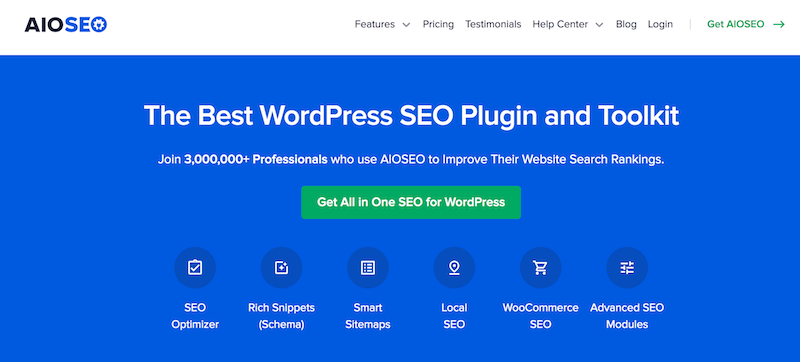
This WordPress tool helps with on-page optimization.
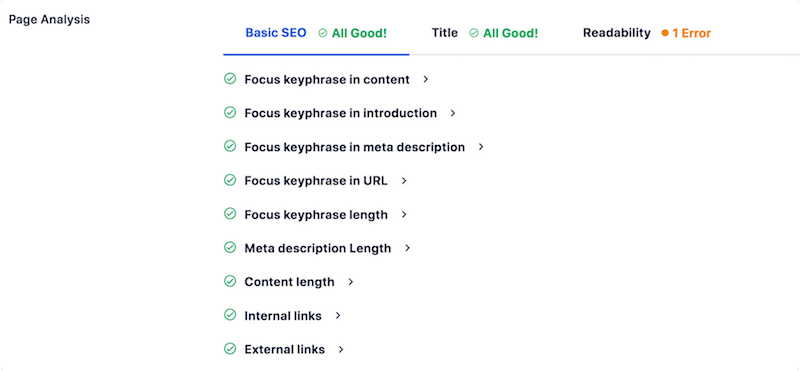
You can use it to optimize title tags and meta descriptions, as well as the optimization and readability of your pages and posts.
Content Marketing
Content marketing involves creating and distributing valuable content to attract and retain a clearly defined audience.
Sharing your expertise can help position you as an authority in your eCommerce niche. Popular types of content to market digital products to consider include:
- Blog posts: Share informative and engaging articles related to your product or industry.
- Ebooks and whitepapers: Create in-depth content to attract and nurture leads.
- Video content: Produce videos to demonstrate your product’s features and benefits.
- Social media content: Share valuable content on your social media channels.
I also recommend creating a dedicated landing page as part of your pre-launch campaign.
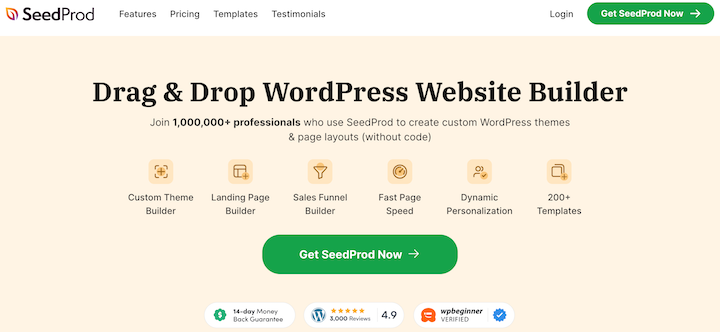
Using a page builder plugin like SeedProd to choose from pre-built templates, you can design a visually appealing landing page that clearly communicates the product’s benefits and encourages sign-ups.
Social Media Marketing
Social media platforms offer a powerful way to connect with your target audience, build relationships, and promote your digital products.
Select the social media channels where your target audience is most active. Then share engaging, relevant content and interact with your followers to help build and nurture your community.
I also recommend using a plugin like RafflePress to run online contests and giveaways.
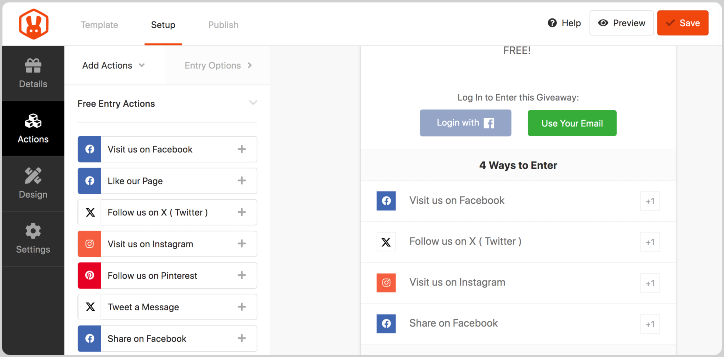
In addition to promoting digital products, contests can help you reach a wider audience and boost engagement.
Easy Digital Downloads Social Discounts add-on can help you motivate your customers to promote your products.
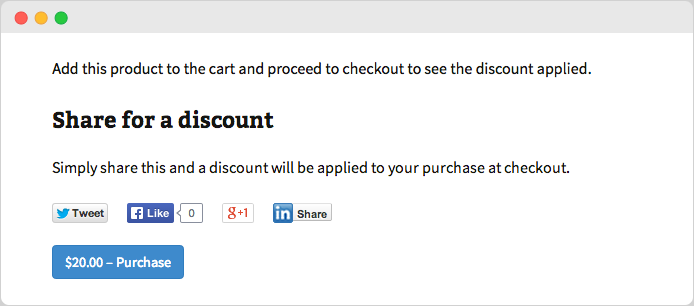
You can use this extension to reward users with special discounts when they share your products with their own followers.
Email Marketing
Email marketing is another highly effective way to market digital products, nurture leads, and convert customers.
Building an email list and sending targeted campaigns with valuable content, promotions, and updates can drive sales.
OptinMonster is the ideal solution for adding lead magnets and opt-ins to your WordPress site.
You can also integrate Easy Digital Downloads with popular email marketing platforms, including Mailchimp, GetResponse, Constant Contact, and more.
To help enhance the success of your email marketing campaigns, segment your audience based on interests, demographics, or behavior. Use eCommerce email automation to send timely and relevant messages to the right audience at the right time.
Affiliate Marketing
Affiliate marketing is a performance-based marketing strategy in which you reward affiliates for each referral sent that results in a sale. It’s a cost-effective way to reach a wider audience and increase sales.
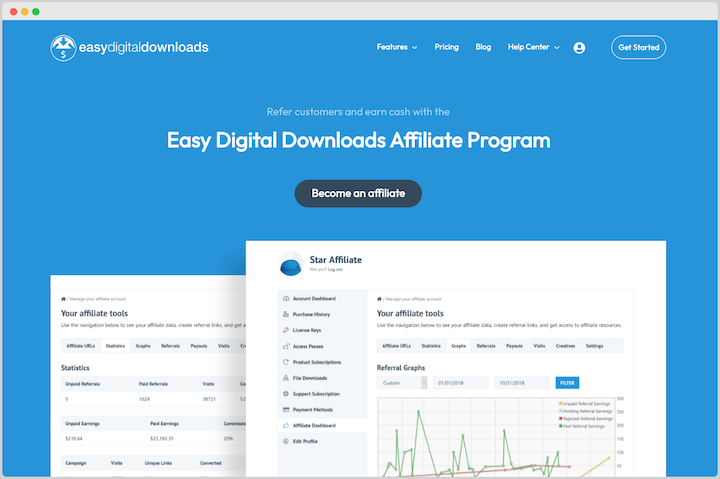
Affiliate marketing works by allowing online sellers to partner with individuals, influencers, or other businesses (known as affiliates). These affiliates promote your products or services through their own channels, such as websites, blogs, social media, or email marketing. When a customer makes a purchase through the affiliate’s unique referral link, they earn a commission.
Affiliate marketing offers several advantages, including:
- No upfront costs, affiliates are paid only when they generate results.
- Increased brand exposure through affiliates reaching new audiences.
- Targeted traffic by affiliates targeting specific demographics and interests.
- Flexibility in promoting products or services in various ways.
For WordPress and Easy Digital Downloads users, AffiliateWP is the ideal plugin to start an affiliate marketing program.
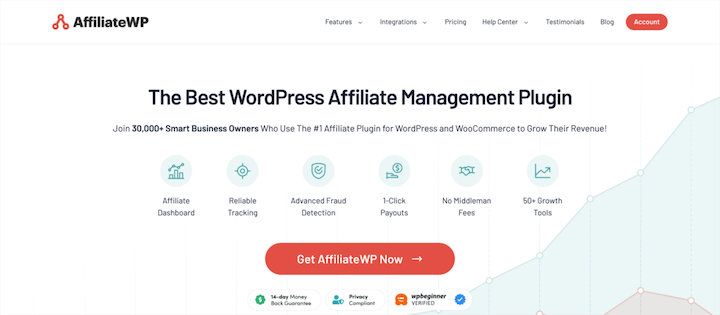
This user-friendly and feature-rich plugin makes it easy to manage affiliates, track referrals, and pay commissions. With AffiliateWP, you can quickly and easily set up an affiliate program to effectively promote and market digital products.
Partner with influencers or other businesses to promote your digital products. Offer attractive commissions to incentivize affiliates to recommend your products to their audience.
Paid Advertising
Paid advertising can help you reach a wider audience and drive traffic to your website. Consider the following options:
- Google Ads: Target potential customers with relevant search queries.
- Social media ads: Reach your target audience on platforms like Facebook, Instagram, and LinkedIn.
- Pay-per-click (PPC) advertising: Pay for each click on your ad.
- Display advertising: Showcase your ads on relevant websites.
By combining these marketing strategies, you can create a comprehensive approach to promoting your digital products and achieving your business goals.
Measuring & Analyzing Results
To improve your marketing efforts, it’s essential to track and analyze your results. By understanding how your campaigns are performing, you can make data-driven decisions to improve results.
| Website traffic | Monitor the number of visitors to your website and identify traffic sources. |
| Conversion rate | Measure the percentage of website visitors who complete a desired action (e.g., purchase, sign-up). |
| Customer acquisition cost (CAC) | Calculate the cost of acquiring a new customer. |
| Customer lifetime value (CLTV) | Determine the total revenue generated by a customer over their lifetime. |
| Return on investment (ROI) | Measure the profitability of your marketing campaigns. |
| Social media engagement | Track likes, shares, comments, and followers on social media platforms. |
| Email open and click-through rates (CTRs) | Measure the effectiveness of your email campaigns. |
Experiment with A/B testing to optimize your campaigns and make data-driven decisions.
To make tracking and monitoring key metrics easier, I recommend using the MonsterInsights plugin to integrate Google Analytics with your WordPress site and Easy Digital Downloads.
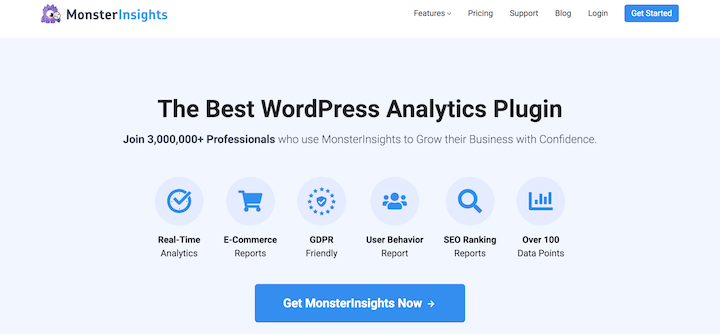
The reports provide comprehensive website traffic data and user behavior insights. You can also utilize the built-in analytics tools of the social and email marketing platforms you’re using.
Key Takeaways
- Understand your target audience and create detailed buyer personas.
- Develop a compelling value proposition that highlights your product’s unique benefits.
- Build a well-structured sales funnel to guide customers through the buying process.
- Choose the right sales channels to reach your target audience.
- Establish a pricing strategy that aligns with your product’s value and market conditions.
- Create a pre-launch campaign to generate excitement and build anticipation.
- Implement effective marketing strategies, including SEO, content marketing, social media, email marketing, and paid advertising.
- Measure and analyze your results to optimize your campaigns.
By implementing these strategies and continuously refining your approach, you can achieve sustainable growth and success in the digital product market.
FAQs About How to Market Digital Products
Let’s wrap up with some frequently asked questions about the best way to market digital products and downloads.
What are the best ways to market digital products?
The best marketing strategies for digital products include SEO, email and social media marketing, content marketing, and paid ads.
What channels should I use to market digital products?
The best channels to use to market digital products depend on your target audience. However, direct sales channels such as your own website are highly effective. I recommend WordPress and Easy Digital Downloads. You can also incorporate social media and email channels to further promote products and drive conversions.
How do I build an audience for my digital product?
To build an audience for your digital product, conduct market research. Once you understand your target audience, add opt-in forms to your site to build an email list. Regularly share relevant, engaging, and high-quality content on your website and social media channels.
Promote + Market Digital Products With EDD
To successfully market digital products, you need a strategic approach that combines understanding your target audience, crafting a compelling value proposition, and implementing effective marketing strategies.
Don’t have Easy Digital Downloads yet? Grab your pass today and get started with a superior online selling experience in no time:
Ready to learn more ways to boost sales and conversions? Check out 9 ways to create a better eCommerce experience!
📣 P.S. Be sure to subscribe to our newsletter and follow us on Facebook or Twitter for more WordPress resources!
Using WordPress and want to get Easy Digital Downloads for free?
Enter the URL to your WordPress website to install.
Disclosure: Our content is reader-supported. This means if you click on some of our links, then we may earn a commission. We only recommend products that we believe will add value to our readers.